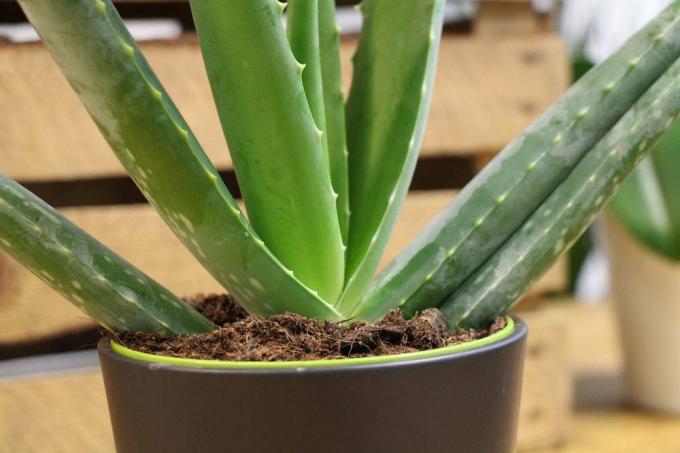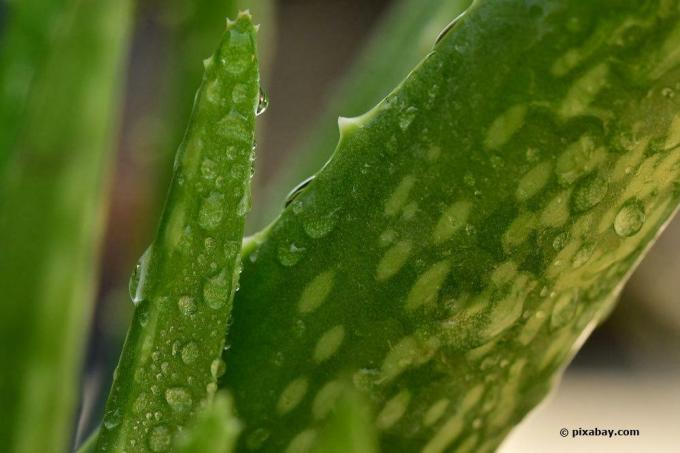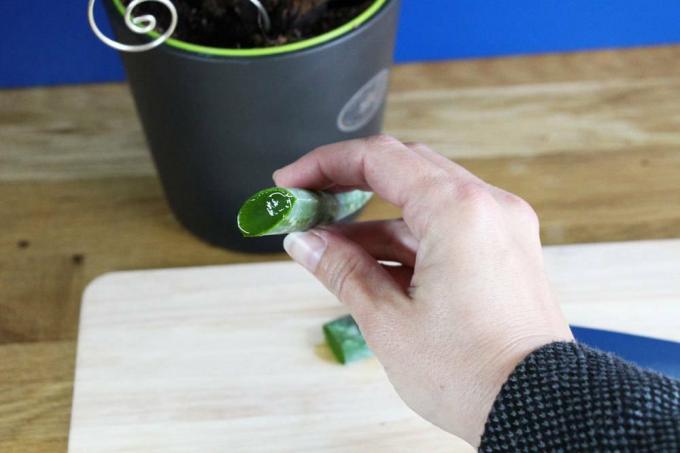
table of contents
- Substrate
- Propagation by cuttings: instructions
- 1. Cut off leaves and dry them
- 2. Fill the pot with substrate
- 3. Plant cuttings
- 4. care
- Propagation by Kindel: Instructions
- 1. Find & cut off Kindel
- 3. Plant Kindel
- 4. care
The real aloe (bot. Aloe vera) is a popular medicinal plant from the Arab region, which is used in folk medicine and cosmetics due to its ingredients. If you have a specimen of the Affodill family yourself, but want to propagate it, there are several methods available. Aloes are quite easy to propagate because they provide a lot of plant material that can be used for this very purpose.
Substrate
Before you can propagate the aloe vera, you should mix the substrate together. Aloes can only thrive in the right substrate and it does not matter whether you propagate cuttings or children, the substrate in the pot must meet certain requirements. In conventional garden soil, the cuttings and leaf cuttings would only die or rot immediately, which of course you want to avoid. The following substrate mixtures are very suitable for aloes:
- 3 parts soil for cacti, 1 part perlite, 1 part lava granulate
- 2.5 parts soil for succulents, 1 part lava granulate, 1 part vermiculite,
- 2.5 parts earth for pricking out, 1 part lava granulate, 1 part pumice gravel, half part quartz sand
These mixtures offer the young aloe plants the necessary conditions to be able to grow effectively. Not only can the roots find support immediately, the aloes can look forward to a rich supply of nutrients and fresh air, while they are not exposed to waterlogging. Mix the ingredients together and check the density of the substrate by squeezing it once. As long as the mixture doesn't collapse again, the mixture is right. Finally, check the pH value. This should be between 6.0 and 8.0. Add some garden lime if the value is not high enough.
Propagation by cuttings: instructions
When propagating cuttings, you also rely on plant material that the mother plant forms. In contrast to the method with cuttings, this method mainly rejuvenates older plants. However, you have to be aware that this type of propagation does not work as effectively and often goes wrong the cut leaf cuttings have a lot of moisture, which causes the cut leaves to rot in the earth leads. Only a few leaf cuttings develop roots, but the method can still work, which in the end leads to a considerable aloe, since the leaves themselves are already larger than cuttings. For this you need:
- Secateurs, alternatively large scissors or a sharp knife
- Pot with drain hole in the bottom
- Drainage material: pottery shards or gravel
- one of the substrate mixes mentioned above
- Root hormone, alternatively cinnamon, willow water or honey
If you are propagating via cuttings, the choice is yours right earth even more important as it will help prevent the leaves from rotting. The variant with the cactus soil is particularly suitable for leaf cuttings and should therefore be used for this variant. They store a lot of moisture and release it to the plant in small quantities, which is particularly important with succulents such as the aloes. Proceed as follows to propagate:
1. Cut off leaves and dry them
First, cut a leaf at least 8 cm long from the adult aloe. The larger the plant, the more leaves you can cut off, but you should never cut too many at once. The scissors or knife should be clean for this in order not to infect the plant with pathogens.
After you've cut the leaves, you will need to store them in a warm, dry place for up to two weeks. Here the leaves have to air dry so that they do not rot in the substrate at the end. They are dried until a white film forms over them, which prevents mold infestation. Once you see this movie, you can start propagating.
2. Fill the pot with substrate
Cover the bottom of the pot thinly with the drainage material. You don't need a lot, only the drainage system has to work.
Then fill the entire pot with soil to about three centimeters below the rim. Be careful not to fill it all the way to the top, otherwise the substrate could be lost.
3. Plant cuttings
Now immerse the leaf in a glass with root hormone to encourage the aloe to form roots, which is quite slow. Alternatively, dip them in honey or ground cinnamon, willow water is also possible. Be careful not to get the leaf cutting too wet before you put it in the ground.
The cuttings are now stuck lengthways into the earth covered with a very thin layer of substrate. A part should still look out of the earth so that light can reach it. Finally, the pot is placed in a sunny and warm place and carefully poured on. Wait until the soil is completely dry before watering again.
4. care
You can tell whether the cuttings take root to multiply when they dry out badly or begin to shrink. With time and proper care, new plants will develop from the leaf. Keep their size and go soft, they rot. No new plants can develop from these leaf cuttings.

tip: A cultivation via seeds is also possible with the real aloe, but it can only take a very long time and is quite laborious. In addition, if the lighting conditions are not correct during germination, the young plant can die quickly, which makes propagation via cuttings or cuttings more effective and safer.
Propagation by Kindel: Instructions
The offspring and offshoots are the same in Aloe vera and describe the “offspring” of the mother plant. These grow next to the mother plant, i.e. the largest specimen, together in the pot, form roots and look very similar to it, only they are smaller and brighter. If you want to propagate aloes using cuttings, you have the greatest chance of success, as these already have roots and theoretically only have to be repotted in order to continue to grow. For this you need:
- sharp knife
- Pot with drain hole in the bottom
- Drainage material: pottery shards or gravel
- one of the substrate mixes mentioned above
- Root hormone, alternatively cinnamon, willow water or honey
Then proceed as follows:
1. Find & cut off Kindel
To separate the children, you should first disinfect the knife so that the offshoots do not catch fire. Then take all of the aloe vera and the soil out of the pot and look for the children. These are attached to the mother plant, but have their own roots, which should be easy to recognize once they have been freed from the earth.
You can easily separate the offshoots from the mother plant with your fingers. If this doesn't work, pick up the knife. Then let the children and the cuttings dry for a few days so that the cut surface can recover. During this time you repot the mother plant.
3. Plant Kindel
Now prepare the substrate as described above for the cuttings. Then just dip the roots of the aloe cuttings in the root hormone or the listed alternatives. Then you can put the specimens in the pots for propagation.
4. care
Moisten the substrate a little, put it in a warm and sunny place and do not water again until a week later.

tip: If the previous pot of the aloe is big enough, you can plant the Kindel directly in the pot after separating it. To do this, you just dig a small hole in the substrate and place the cuttings directly next to the mother plant, because they can no longer grow together after separation.



